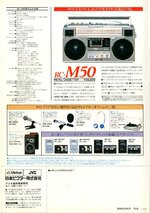I didn’t mean to cause any contention; just stating what we observed because I was in strong disbelief as well. We= three people, one of whom is the restorer, as experienced with boomboxes as some of you guys, across all boxes from the 70s and 80s. Also another collector with sensitive ears. We even did a quick battle with Panasonic 5350 (I listened to this) but it was very quick because the Panasonic was just on a different level, as nice as it is. We also compared against an Aiwa CS880 and the Aiwa stood up really well.
Anyway, just to say these are practical tests on machines that came in not working conditions and had the mechanics restored and cleaning of switches snd pots.. At the end, they worked equally well and sounded identically (all 4 Victors on the one hand and the reference JVC on the other).
No recapping, all original (why recap if it’s working great?) By the way if recapping is done, then it should be done with the same type of new caps because I have read that the choice of caps and chemistry inside will influence the sound. And again, why recap unless a model is known to have leaky or deteriorated caps? From what I have read, caps aren’t an issue for this model.
We didn’t swap the speakers, that would be a nice experiment but it would only explain the why. Ideally we need the Victor schematics but it’s nowhere to be found.
If anyone is keen to repeat the test, definitely you should keep the power supply as a constant. I have seen people plugging the Victors or Canadian JVCs in the US mains, which sounds wrong.
One more observation: the DC power supply for m90s is different. Some have 15v written on the back and some 12v. This is also stated on the service manuals for the export versions. The difference is there between export versions. The Victor has 15v. This puzzles me because they all take 10 batteries. Cars around the world run on the same voltage too. There is a US box with 61w has 12v and multi-AC voltage. Then the Canadian m90 has 70w written and 12v DC. I attribute this to the convention in the counties but it makes me wonder what DC adapter is safest to use.
Final food for thought: the top JVC deck TD V 1010 is the export version of Victor TDV 721. You’d think they are the same but apparently they are not, based on Tapeheads, the domestic version is slightly better. Just goes to say there are other examples like this even by the Victor company.
Anyway, just to say these are practical tests on machines that came in not working conditions and had the mechanics restored and cleaning of switches snd pots.. At the end, they worked equally well and sounded identically (all 4 Victors on the one hand and the reference JVC on the other).
No recapping, all original (why recap if it’s working great?) By the way if recapping is done, then it should be done with the same type of new caps because I have read that the choice of caps and chemistry inside will influence the sound. And again, why recap unless a model is known to have leaky or deteriorated caps? From what I have read, caps aren’t an issue for this model.
We didn’t swap the speakers, that would be a nice experiment but it would only explain the why. Ideally we need the Victor schematics but it’s nowhere to be found.
If anyone is keen to repeat the test, definitely you should keep the power supply as a constant. I have seen people plugging the Victors or Canadian JVCs in the US mains, which sounds wrong.
One more observation: the DC power supply for m90s is different. Some have 15v written on the back and some 12v. This is also stated on the service manuals for the export versions. The difference is there between export versions. The Victor has 15v. This puzzles me because they all take 10 batteries. Cars around the world run on the same voltage too. There is a US box with 61w has 12v and multi-AC voltage. Then the Canadian m90 has 70w written and 12v DC. I attribute this to the convention in the counties but it makes me wonder what DC adapter is safest to use.
Final food for thought: the top JVC deck TD V 1010 is the export version of Victor TDV 721. You’d think they are the same but apparently they are not, based on Tapeheads, the domestic version is slightly better. Just goes to say there are other examples like this even by the Victor company.





 Most of my values have gone down..haha.
Most of my values have gone down..haha.